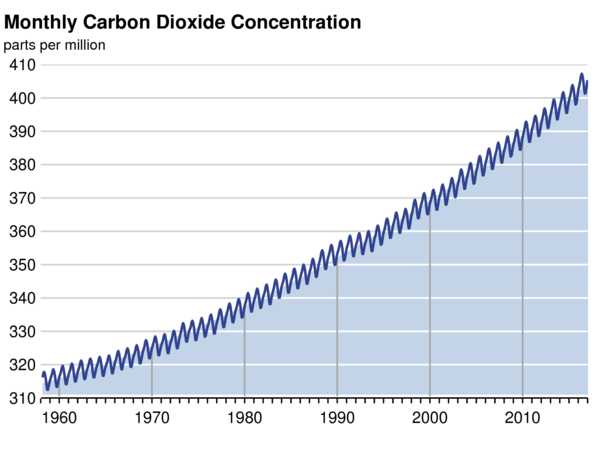Scripps CO2 Program Data
About this collection
- Extent
-
4 digital objects.
- Cite This Work
-
Keeling, Ralph F.; Keeling, Charles D. (2017). Scripps CO2 Program Data. UC San Diego Library Digital Collections. https://doi.org/10.6075/J0542KSG
- Description
-
The Scripps CO2 program was initiated in 1956 by Charles David Keeling and operated under his direction until his passing in 2005. It is currently being continued by Ralph F. Keeling, who also runs a parallel program at SIO to measure changes in atmospheric O2 and Ar abundances (Scripps O2 Program).
The Scripps CO2 program has made measurements of atmospheric CO2 concentration and the isotopic abundances 13C/12C, 14C/C, and 18O/16O ratios of CO2 from a network of stations from nearly Pole to Pole, along a Pacific transect. The primary (in situ) record from Mauna Loa Observatory, Hawaii is based on measurements made with an analyzer at the site. In situ records are also available from La Jolla. At all other sampling stations, the records are based on flask samples returned to the laboratory at the Scripps Institution of Oceanography for analysis. Flasks have also been redundantly collected at Mauna Loa and La Jolla.
Current results, including data sets and graphics, are available at http://scrippsco2.ucsd.edu from the ongoing program to measure CO2 and chemical species.
For daily updates of the CO2 Concentration at Mauna Loa Obervatory, Hawaii, see https://scripps.ucsd.edu/programs/keelingcurve/
Measurements of atmospheric CO2 concentration from the Scripps CO2 program began in 1957 at La Jolla, California and at the South Pole, and in 1958 at Mauna Loa Observatory. These measurements were gradually extended during the 1960's and 1970's to comprise sampling at an array of stations from the Arctic to Antarctica. Isotopic measurements began in 1978 at selected stations, expanding over time to include additional stations.
The Scripps CO2 program is operationally independent from the Scripps O2 program in using different flasks and analysis systems. The CO2 records of these two programs are therefore substantially independent, even though the flasks for both programs are collected at many of the same stations. - Scope And Content
-
The Scripps CO2 Program website at http://scrippsco2.ucsd.edu provides access to openly available atmospheric and seawater CO2 concentration data from various sources. Redundant copies of the atmospheric CO2 data from 14 sampling stations are being deposited here, through the UC San Diego Library, to provide enhanced discovery, long-term accessibility, and preservation. The latest data archives from the 10 active stations are added to this collection as they become available.
- Date Collected
- 1957 to present
- Date Issued
- 2017
- Creator
- Director
- Contributors
- Note
-
Data Usage:
The data and graphics on this website are made freely available, with the understanding that appropriate credit will be given. For applications supporting peer-reviewed scientific publications, coauthorship may sometimes be appropriate. An example would be if an important result or conclusion depends on this product, such as the first account of a previously unreported phenomenon. Ethical usage requires disclosing intentions at early stages of the work in order to avoid duplicating ongoing studies at Scripps. For applications where coauthorship is not needed, which includes all applications outside of the peer-reviewed scientific literature, it is sufficient to acknowledge the Scripps CO2 program as the source. Please direct queries to Ralph Keeling (rkeeling@ucsd.edu). - Funding
-
The Scripps CO2 program is currently supported by the National Science Foundation (NSF), National Aeronautics and Space Administration (NASA), the Eric and Wendy Schmidt Fund for Strategic Innovation.
In kind support for field operations is provided by the National Oceanographic and Atmospheric Administration (NOAA), the National Science Foundation (NSF), Environment and Climate Change Canada, the New Zealand National Institute for Water and Atmospheric Research (NIWA), and by Earth Networks. - Topics
Formats
View formats within this collection
- Language
- English
- Identifier
- Related Resources
- Keeling Curve at Scripps Institution of Oceanography: https://scripps.ucsd.edu/programs/keelingcurve/
- Scripps CO2 Program: http://scrippsco2.ucsd.edu/
- Scripps O2 Program Data at UC San Diego Library: https://doi.org/10.6075/J0WS8RJR
- Scripps O2 Program: http://scrippso2.ucsd.edu/
- C. D. Keeling, S. C. Piper, R. B. Bacastow, M. Wahlen, T. P. Whorf, M. Heimann, and H. A. Meijer, Atmospheric CO2 and 13CO2 exchange with the terrestrial biosphere and oceans from 1978 to 2000: observations and carbon cycle implications, pages 83-113, in "A History of Atmospheric CO2 and its effects on Plants, Animals, and Ecosystems", editors, Ehleringer, J.R., T. E. Cerling, M. D. Dearing, Springer Verlag, New York, 2005. https://doi.org/10.1007/0-387-27048-5_5
- C. D. Keeling, S. C. Piper, R. B. Bacastow, M. Wahlen, T. P. Whorf, M. Heimann, and H. A. Meijer, Exchanges of atmospheric CO2 and 13CO2 with the terrestrial biosphere and oceans from 1978 to 2000. I. Global aspects, SIO Reference Series, No. 01-06, Scripps Institution of Oceanography, San Diego, 88 pages, 2001. https://escholarship.org/uc/item/09v319r9
Related data
Reference
 Library Digital Collections
Library Digital Collections
